Kenya 2010
Trip Report
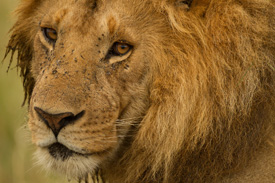
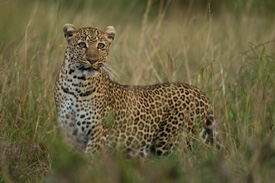
See our 2010 Kenya Portfolio
Read our 2011 Kenya Photo Safari Brochure
Seven weeks in Africa, incorporating three different Kenya safaris and one extremely productive trip to Rwanda for the Mountain Gorillas. Mid-October through November coincides with the short rainy season, and during our stay we were often treated to magnificent brooding skies, picturesque towering cumulous clouds, and, to occasionally change the pace, brief periods of rain. Throughout, however, we never lost a game-drive to rain, but instead the occasional precipitation added another dimension to our shooting, bringing cooler temperatures that often activated the wildlife.
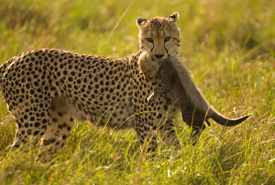 Each trip is totally different, and it is for that very reason that Mary and I never get tired of Kenya, Rwanda, or any of our other African destinations. For example, on one trip we watched a female Cheetah carrying one of her month-old young across the grassland. This behavior is very rarely seen, and our guides, who spend a good part of every year afield, and who have, collectively over 100 years of experience (based in years driving, not days in the field), two of our five guides had seen this behavior one other time, while for the other three it was a first! For Mary and I, in our twenty-plus years of leading photo safaris here, it was a first as well.
Each trip is totally different, and it is for that very reason that Mary and I never get tired of Kenya, Rwanda, or any of our other African destinations. For example, on one trip we watched a female Cheetah carrying one of her month-old young across the grassland. This behavior is very rarely seen, and our guides, who spend a good part of every year afield, and who have, collectively over 100 years of experience (based in years driving, not days in the field), two of our five guides had seen this behavior one other time, while for the other three it was a first! For Mary and I, in our twenty-plus years of leading photo safaris here, it was a first as well.
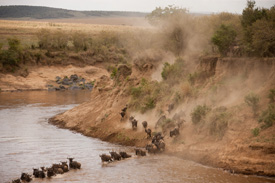
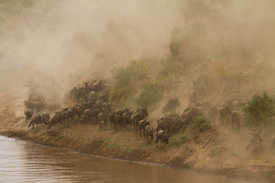
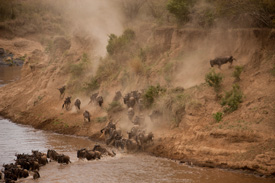
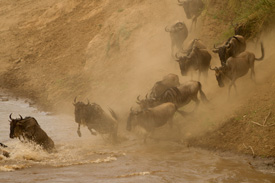
One of our safaris had one of the most dramatic Gnu, or Wildebeest, river crossings we’d ever seen. Thousands of gnus poured over a steep river bank, jumping into the Mara River and forming a long, sweeping U as the herd’s core was pushed downstream by the powerful current. Incredibly, two tourists (overly enthusiast, or idiotic, uncontrolled photographers – take your pick) took their vehicle to a hidden spot where the two climbed out of the vehicle (License Plate: Kenya KBK 405V) and moved through the low bushes to the river bank edge. One then walked down a hippo chute to get closer to the river, while the other man moved through the low trees to be almost within the herd. The gnus panicked and ran everywhere, with the net result being that this great crossing was stopped dead by their actions. When we saw this, everyone on the opposite bank – where we were observing this – started yelling, telling these two obnoxious people that they were ruining the migration and this unique viewing opportunity. They didn’t take heed, and only stopped when the herds ran off. Then, they slunk back into their vehicle and drove off, but not before we trained our long lenses on the vehicle and got their plate. Whether or not the Kenya Wildlife Service will do anything about that is a whole other matter.
Luckily, that crossing wasn’t over, and the herd did return, and this time, instead of channeling down a hippo chute that gnus clustered on the steep bank edge and leaped down, straight off the bank, risking limb breakage and more. Reaching the river’s edge the gnus jumped off, splashing into the brown water in cascading sheets, one after the other. The interruption actually resulted in two very different looks, two totally unique crossings, which was great for our photography but that wasn’t the point. What those two guys did was reckless and uncaring, and had a lion been in wait, or had a gnu bull taken issue with their presence, their action could have been fatal.
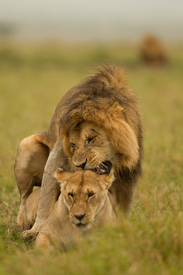 Every safari is different, and our African Lion activity clearly illustrated that fact as well. While one group had fully mature, black-maned lions at all of our locations in the Masai Mara, and nearly all of these were mating, our other two safaris saw only one mating. But that safari had only one opportunity with young lion cubs, while the other safaris had lion cubs on numerous occasions. These, it must be noted, were not the product of the matings we’d seen, since the time frame was too short, but just illustrates how luck, and different dates, makes things so unique. That said, one time isn’t any better than the other, for mating or cubs or crossings, it just happens.
Every safari is different, and our African Lion activity clearly illustrated that fact as well. While one group had fully mature, black-maned lions at all of our locations in the Masai Mara, and nearly all of these were mating, our other two safaris saw only one mating. But that safari had only one opportunity with young lion cubs, while the other safaris had lion cubs on numerous occasions. These, it must be noted, were not the product of the matings we’d seen, since the time frame was too short, but just illustrates how luck, and different dates, makes things so unique. That said, one time isn’t any better than the other, for mating or cubs or crossings, it just happens.
Everyone always hopes to witness a kill, and, quite ironically, our third, and very shortest safari, had perhaps the best luck. This third trip was special, comprised of Mary’s family members – a brother and his wife, and two cousins and their spouses, and we had only three full days in the Masai Mara in this very short trip. Yet luck was with us, and on the first day, while we waited by the Mara River for an unexpected river crossing, several large crocodiles gathered as the herd entered the river. As often happens, that crossing fizzled out and the gnus and zebras that had entered the water moved back to shore and wandered off. The herd stayed nearby and eventually one young gnu calf reentered the water. A huge Nile Crocodile was lurking nearby, its three foot long head almost resting on the river bank. The calf drank, and the crocodile moved in, swimming from upstream until its head was next to the gnu’s flank. It lunged, and the calf seemingly popped out of its jaws. It missed! Incredibly, the gnu calf didn’t flee from the river but merely moved a few yards further downstream, and the crocodile followed. It lunged again, snapping its jaws wide, and the gnu calf darted sideways, dodging the jaws. In the split second that our motor-drives captures we saw that the croc snapped again, and the second snap caught the gnu’s foreleg, pulling it off-balance. Seconds later, the calf was dragged mid-stream, where other huge crocs soon gathered, and the calf was dismembered.
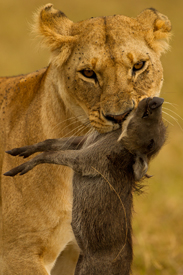 In the three days of this little safari the family saw a Lioness capture a baby warthog, a Cheetah miss, twice, a baby Common Zebra, bravely rescued by its mother and the herd, another Lioness hunt, but fail to charge, a Topi, and a great African Leopard sighting. Great luck, great Karma, and this simply illustrates how many great, exciting events can happen, even in a short period of time.
In the three days of this little safari the family saw a Lioness capture a baby warthog, a Cheetah miss, twice, a baby Common Zebra, bravely rescued by its mother and the herd, another Lioness hunt, but fail to charge, a Topi, and a great African Leopard sighting. Great luck, great Karma, and this simply illustrates how many great, exciting events can happen, even in a short period of time.
Other trip highlights included an exciting observation of a Spotted Hyena worrying and attacking an injured Common Zebra that was repeatedly rescued by her herd-mates, who, whenever the hyena came close, ran in, en masse, and drove the hyena off. The zebra had a serious wound that the hyena had inflicted, and her foreleg had been skinned clean by the hyena’s first attack. Eventually, the hyena lost interest and loped off, and, at the end of the day, we saw the injured zebra, still limping slowly across the Mara plains.
Between our two main Kenya safaris we had offered another Rwanda Mountain Gorilla Photo Shoot, timing it so that participants from the first or second safari could take part. Two from our first safari joined us, and four others flew in special for this shoot, which proved to be one of the most successful and rewarding we’d ever had here.
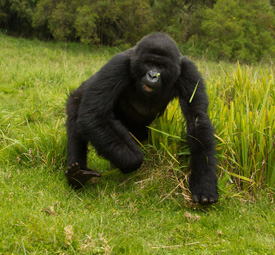 And we’ve had a lot, as this trip marked our 51st through 55th Mountain Gorilla trek, expanding our ‘record’ of having more visits than anyone else to this magical location. Park records verify this, as the next highest visitation is from a single individual, not a couple who brings groups with them! The Park appreciates our patronage and it shows, but, ultimately, it is good karma and luck that determines a good shoot, and this year’s was, perhaps, the best ever. Why? Great weather, where it never rained while we were shooting, good shooting conditions, where gorillas were not in deep, thick cover or bright sunlight, and incredible behavior. And we had all three, including, for me at least, the closest I’ve come to my dream shot, a silverback gorilla beating its chest and charging the camera. My shot, done with a 28-300mm zoom, was of a black-back, a male not quite in its prime, that rose up from a resting position and charged past us, its open hands slapping its chest in the distinctive ‘pop-pop-pop’ slaps of its display. Mary and I always use the rear thumb-button for focusing (disengaging the meter/shutter button from focus), and as the gorilla rushed past I thought I forgot to press in my thumb. My ‘muscle memory’ immediately after the event told me I missed, and I was really beating myself up for missing the chance. When I got back to our lodge, however, I found that I must have simply stuttered my thumb off the button at the end of the charge, and it was that that I recalled. I had, in fact, caught the focus and the charge.
And we’ve had a lot, as this trip marked our 51st through 55th Mountain Gorilla trek, expanding our ‘record’ of having more visits than anyone else to this magical location. Park records verify this, as the next highest visitation is from a single individual, not a couple who brings groups with them! The Park appreciates our patronage and it shows, but, ultimately, it is good karma and luck that determines a good shoot, and this year’s was, perhaps, the best ever. Why? Great weather, where it never rained while we were shooting, good shooting conditions, where gorillas were not in deep, thick cover or bright sunlight, and incredible behavior. And we had all three, including, for me at least, the closest I’ve come to my dream shot, a silverback gorilla beating its chest and charging the camera. My shot, done with a 28-300mm zoom, was of a black-back, a male not quite in its prime, that rose up from a resting position and charged past us, its open hands slapping its chest in the distinctive ‘pop-pop-pop’ slaps of its display. Mary and I always use the rear thumb-button for focusing (disengaging the meter/shutter button from focus), and as the gorilla rushed past I thought I forgot to press in my thumb. My ‘muscle memory’ immediately after the event told me I missed, and I was really beating myself up for missing the chance. When I got back to our lodge, however, I found that I must have simply stuttered my thumb off the button at the end of the charge, and it was that that I recalled. I had, in fact, caught the focus and the charge.
As I write this, hours away from boarding my KLM flight back to Amsterdam and then on to New York, and eventually to home, the above recollections simply stand out as illustrative of the action and activity we saw each day. As usual, I kept and have posted our day-to-day Trip Journal for the two official safaris, where I’ve included more photos and more details on each day’s events.
Next year, in 2011, our schedule restricts us to doing only two Kenya Photo Safaris, and although we have a large inquiry list, if you are interested, you may want to contact our office and be placed on that list. However, in 2012 we’re planning on spending most of the fall in Kenya, from mid-October until mid-December, offering three or four safaris during this period. If interested, contact our office NOW to get on that notification list.
But one caution. If you’ve never been to Kenya, if you’ve never been on safari, beware. Don’t think that it is a once-and-done deal, a ‘been-there, done-that’ experience. Kenya, East Africa, and safaris will get in your blood, and you’ll only want to return, again and again. It never gets old, and it’s always great. So, you’ve been warned!
Our 2011 Safari Brochure is now available.
15 day trip


On Trip One, we had an exciting hunt where a lioness captured a young reedbuck.
On Trip Two, we had several opportunities to photograph cubs, at play and with their mother..
The Migration
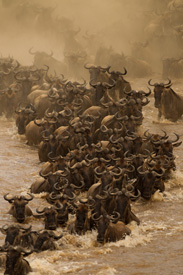 One of the events everyone hopes to see is the gnu, or wildebeest, migration. Erroneouly, many think that this requires crossing the Mara River, which lies on the western edge of the migratory route. In truth, gnus can travel into the Masai Mara and back into the Serengeti without crossing the Mara, just as gnus may cross the river, back and forth, several times while they are in the Mara.
One of the events everyone hopes to see is the gnu, or wildebeest, migration. Erroneouly, many think that this requires crossing the Mara River, which lies on the western edge of the migratory route. In truth, gnus can travel into the Masai Mara and back into the Serengeti without crossing the Mara, just as gnus may cross the river, back and forth, several times while they are in the Mara.
Nonetheless, a river crossing can be exciting. When Mary and I first started going to the Mara, the gnu migration followed what may have been an historic pattern, entering the Mara in June and leaving some time during September. Since the phenonmenon of the migration really started in the 1950s, its hard to say if that June to September pattern was natural, or an artifact of the times. Today, gnus still enter the Mara in June, but gnu herds, in size from small groups to massive herds, may still be present in December.
This year, the gnus were in the Mara in huge numbers during our first trip and we had one of the most exciting river crossings we ever had. On our second trip, returning to the Mara about two weeks later, large herds were still present, but the gnus were not moving. They seemed content to graze on whatever side of the river they were on, and we had no crossings. On our third, very short trip to the Mara, most of the gnus were gone, but we almost had a river crossing, but the attack of a large crocodile stopped that one, cold.

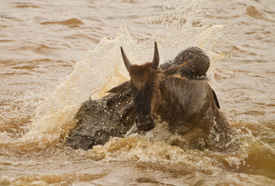
The image on the left was from 2009, the one on the right from this year, 2010. My point:
each year new opportunities arise, and while similar events or behaviors may occur, the images
that result are never the same. Consequently, it is always exciting!
The Predators
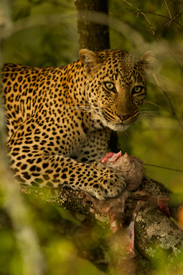
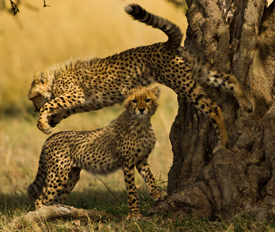
Predators are always a sought-after subject, and, as usual, we had wonderful luck. On both trips we had at least ten leopard sightings, over twenty cheetah sightings, and well over 100 lion sightings. Not all of these resulted in great photographs, but at least half of each of these did, and included lions chasing giraffes, topis, and warthogs, cheetahs carrying cubs and chasing game, and leopards feeding on waterbucks, walking, stalking, and climbing trees.
As noted above, each trip is different, and while our first safari had several lions mating but very few lion cubs, on our second safari we had only one mating but we had cubs in three different locations in the Mara. On the third trip, our short little family safari, we had a successful lion hunt, where a lioness captured a baby warthog, a lioness carrying a three-week-old cub, and another, but unsuccessful, hunt.
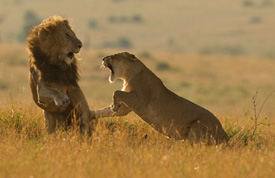
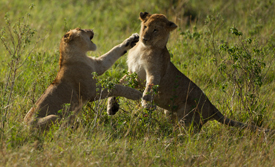
The Birds
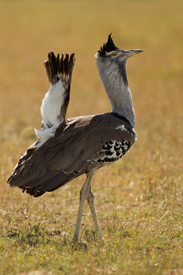
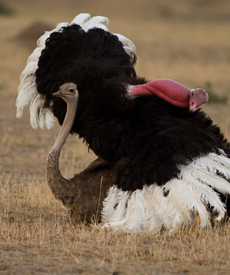
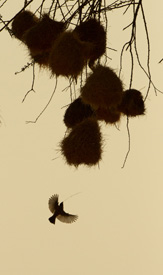
The wealth of Kenyan birds often surprised and always delights photographers. Many photographers initially have little interest in birds, or so they say, and these photographers often list the birds as their favorite subjects, since they were completely unprepared for how much fun, and variety, birds provide.
This year's bird shooting was especially rewarding. We had a wonderful Kori Bustard display, where this larger-than-turkey-sized bird cocks its tail over its back and inflates its neck to two or three times its normal size. On our last trip Masai Ostriches were actively mating, and in one morning we had three different matings in the course of an hour. On the other safaris, conversely, we had adults with plenty of chicks, with one pair shepherding 48 chicks in tow! We had several Secretarybird nests, and one lucky group watched a bird swallowing a venomous Black Mamba!

Birds of Prey were common, with great shots of some species we'd never photographed before. Although I didn't get to shoot it, I watched a Martial Eagle swoop down upon a Banded Mongoose and miss. The bird was driven off by a mob of other mongooses that ran to the aid of the potential victem, and we watched with amazement when two mongooses leaped into the air like tawny missles, trying to grab the fleeing eagle!
Other Highlights

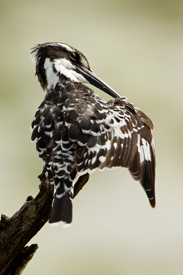
As a picture tells a thousands words, looking at our Trip Portfolios will most clearly tell the story of our highlights. Two that really stand out, however, occured on the second safari. We rarely see baby, black-colored Spotted Hyenas, and in all our years we've only had a few chances to photograph a mother carrying a little baby. This year we had two great chances, on both the second and the family safari.
On the second safari, we also had the most cooperative Pied Kingfisher I've ever had in Kenya. We slowly moved up on a bird sitting on a perch, expecting that at some point the bird would fly off, hunting or visiting another perch. This one didn't, and we spent nearly an hour with the bird as we waited for it to dive into the water for prey. Instead, it captured a dragonfly on shore, but it flew back to our perch where it tossed it into the air several times before swallowing its prey. Exhausted of the photo ops, we finally gave up and drove off.
See Mary's Portfolio from these trips.
For even more details about either safari, read my daily journal for Safari Trip One or Safari Trip Two.
Interested in doing one of our safaris? Check out our brochure.
For some real insight into all aspects of a photo safari,
order our DVD Photographing on Safari
which covers and illustrates various camps,
how to shoot from the vehicles, what to pack,
and most importantly, what you'll photograph
and how you'll do so.
Kenya 2010
Trip Report


See our 2010 Kenya Portfolio
Read our 2011 Kenya Photo Safari Brochure
Seven weeks in Africa, incorporating three different Kenya safaris and one extremely productive trip to Rwanda for the Mountain Gorillas. Mid-October through November coincides with the short rainy season, and during our stay we were often treated to magnificent brooding skies, picturesque towering cumulous clouds, and, to occasionally change the pace, brief periods of rain. Throughout, however, we never lost a game-drive to rain, but instead the occasional precipitation added another dimension to our shooting, bringing cooler temperatures that often activated the wildlife.
 Each trip is totally different, and it is for that very reason that Mary and I never get tired of Kenya, Rwanda, or any of our other African destinations. For example, on one trip we watched a female Cheetah carrying one of her month-old young across the grassland. This behavior is very rarely seen, and our guides, who spend a good part of every year afield, and who have, collectively over 100 years of experience (based in years driving, not days in the field), two of our five guides had seen this behavior one other time, while for the other three it was a first! For Mary and I, in our twenty-plus years of leading photo safaris here, it was a first as well.
Each trip is totally different, and it is for that very reason that Mary and I never get tired of Kenya, Rwanda, or any of our other African destinations. For example, on one trip we watched a female Cheetah carrying one of her month-old young across the grassland. This behavior is very rarely seen, and our guides, who spend a good part of every year afield, and who have, collectively over 100 years of experience (based in years driving, not days in the field), two of our five guides had seen this behavior one other time, while for the other three it was a first! For Mary and I, in our twenty-plus years of leading photo safaris here, it was a first as well.




One of our safaris had one of the most dramatic Gnu, or Wildebeest, river crossings we’d ever seen. Thousands of gnus poured over a steep river bank, jumping into the Mara River and forming a long, sweeping U as the herd’s core was pushed downstream by the powerful current. Incredibly, two tourists (overly enthusiast, or idiotic, uncontrolled photographers – take your pick) took their vehicle to a hidden spot where the two climbed out of the vehicle (License Plate: Kenya KBK 405V) and moved through the low bushes to the river bank edge. One then walked down a hippo chute to get closer to the river, while the other man moved through the low trees to be almost within the herd. The gnus panicked and ran everywhere, with the net result being that this great crossing was stopped dead by their actions. When we saw this, everyone on the opposite bank – where we were observing this – started yelling, telling these two obnoxious people that they were ruining the migration and this unique viewing opportunity. They didn’t take heed, and only stopped when the herds ran off. Then, they slunk back into their vehicle and drove off, but not before we trained our long lenses on the vehicle and got their plate. Whether or not the Kenya Wildlife Service will do anything about that is a whole other matter.
Luckily, that crossing wasn’t over, and the herd did return, and this time, instead of channeling down a hippo chute that gnus clustered on the steep bank edge and leaped down, straight off the bank, risking limb breakage and more. Reaching the river’s edge the gnus jumped off, splashing into the brown water in cascading sheets, one after the other. The interruption actually resulted in two very different looks, two totally unique crossings, which was great for our photography but that wasn’t the point. What those two guys did was reckless and uncaring, and had a lion been in wait, or had a gnu bull taken issue with their presence, their action could have been fatal.
 Every safari is different, and our African Lion activity clearly illustrated that fact as well. While one group had fully mature, black-maned lions at all of our locations in the Masai Mara, and nearly all of these were mating, our other two safaris saw only one mating. But that safari had only one opportunity with young lion cubs, while the other safaris had lion cubs on numerous occasions. These, it must be noted, were not the product of the matings we’d seen, since the time frame was too short, but just illustrates how luck, and different dates, makes things so unique. That said, one time isn’t any better than the other, for mating or cubs or crossings, it just happens.
Every safari is different, and our African Lion activity clearly illustrated that fact as well. While one group had fully mature, black-maned lions at all of our locations in the Masai Mara, and nearly all of these were mating, our other two safaris saw only one mating. But that safari had only one opportunity with young lion cubs, while the other safaris had lion cubs on numerous occasions. These, it must be noted, were not the product of the matings we’d seen, since the time frame was too short, but just illustrates how luck, and different dates, makes things so unique. That said, one time isn’t any better than the other, for mating or cubs or crossings, it just happens.
Everyone always hopes to witness a kill, and, quite ironically, our third, and very shortest safari, had perhaps the best luck. This third trip was special, comprised of Mary’s family members – a brother and his wife, and two cousins and their spouses, and we had only three full days in the Masai Mara in this very short trip. Yet luck was with us, and on the first day, while we waited by the Mara River for an unexpected river crossing, several large crocodiles gathered as the herd entered the river. As often happens, that crossing fizzled out and the gnus and zebras that had entered the water moved back to shore and wandered off. The herd stayed nearby and eventually one young gnu calf reentered the water. A huge Nile Crocodile was lurking nearby, its three foot long head almost resting on the river bank. The calf drank, and the crocodile moved in, swimming from upstream until its head was next to the gnu’s flank. It lunged, and the calf seemingly popped out of its jaws. It missed! Incredibly, the gnu calf didn’t flee from the river but merely moved a few yards further downstream, and the crocodile followed. It lunged again, snapping its jaws wide, and the gnu calf darted sideways, dodging the jaws. In the split second that our motor-drives captures we saw that the croc snapped again, and the second snap caught the gnu’s foreleg, pulling it off-balance. Seconds later, the calf was dragged mid-stream, where other huge crocs soon gathered, and the calf was dismembered.
 In the three days of this little safari the family saw a Lioness capture a baby warthog, a Cheetah miss, twice, a baby Common Zebra, bravely rescued by its mother and the herd, another Lioness hunt, but fail to charge, a Topi, and a great African Leopard sighting. Great luck, great Karma, and this simply illustrates how many great, exciting events can happen, even in a short period of time.
In the three days of this little safari the family saw a Lioness capture a baby warthog, a Cheetah miss, twice, a baby Common Zebra, bravely rescued by its mother and the herd, another Lioness hunt, but fail to charge, a Topi, and a great African Leopard sighting. Great luck, great Karma, and this simply illustrates how many great, exciting events can happen, even in a short period of time.
Other trip highlights included an exciting observation of a Spotted Hyena worrying and attacking an injured Common Zebra that was repeatedly rescued by her herd-mates, who, whenever the hyena came close, ran in, en masse, and drove the hyena off. The zebra had a serious wound that the hyena had inflicted, and her foreleg had been skinned clean by the hyena’s first attack. Eventually, the hyena lost interest and loped off, and, at the end of the day, we saw the injured zebra, still limping slowly across the Mara plains.
Between our two main Kenya safaris we had offered another Rwanda Mountain Gorilla Photo Shoot, timing it so that participants from the first or second safari could take part. Two from our first safari joined us, and four others flew in special for this shoot, which proved to be one of the most successful and rewarding we’d ever had here.
 And we’ve had a lot, as this trip marked our 51st through 55th Mountain Gorilla trek, expanding our ‘record’ of having more visits than anyone else to this magical location. Park records verify this, as the next highest visitation is from a single individual, not a couple who brings groups with them! The Park appreciates our patronage and it shows, but, ultimately, it is good karma and luck that determines a good shoot, and this year’s was, perhaps, the best ever. Why? Great weather, where it never rained while we were shooting, good shooting conditions, where gorillas were not in deep, thick cover or bright sunlight, and incredible behavior. And we had all three, including, for me at least, the closest I’ve come to my dream shot, a silverback gorilla beating its chest and charging the camera. My shot, done with a 28-300mm zoom, was of a black-back, a male not quite in its prime, that rose up from a resting position and charged past us, its open hands slapping its chest in the distinctive ‘pop-pop-pop’ slaps of its display. Mary and I always use the rear thumb-button for focusing (disengaging the meter/shutter button from focus), and as the gorilla rushed past I thought I forgot to press in my thumb. My ‘muscle memory’ immediately after the event told me I missed, and I was really beating myself up for missing the chance. When I got back to our lodge, however, I found that I must have simply stuttered my thumb off the button at the end of the charge, and it was that that I recalled. I had, in fact, caught the focus and the charge.
And we’ve had a lot, as this trip marked our 51st through 55th Mountain Gorilla trek, expanding our ‘record’ of having more visits than anyone else to this magical location. Park records verify this, as the next highest visitation is from a single individual, not a couple who brings groups with them! The Park appreciates our patronage and it shows, but, ultimately, it is good karma and luck that determines a good shoot, and this year’s was, perhaps, the best ever. Why? Great weather, where it never rained while we were shooting, good shooting conditions, where gorillas were not in deep, thick cover or bright sunlight, and incredible behavior. And we had all three, including, for me at least, the closest I’ve come to my dream shot, a silverback gorilla beating its chest and charging the camera. My shot, done with a 28-300mm zoom, was of a black-back, a male not quite in its prime, that rose up from a resting position and charged past us, its open hands slapping its chest in the distinctive ‘pop-pop-pop’ slaps of its display. Mary and I always use the rear thumb-button for focusing (disengaging the meter/shutter button from focus), and as the gorilla rushed past I thought I forgot to press in my thumb. My ‘muscle memory’ immediately after the event told me I missed, and I was really beating myself up for missing the chance. When I got back to our lodge, however, I found that I must have simply stuttered my thumb off the button at the end of the charge, and it was that that I recalled. I had, in fact, caught the focus and the charge.
As I write this, hours away from boarding my KLM flight back to Amsterdam and then on to New York, and eventually to home, the above recollections simply stand out as illustrative of the action and activity we saw each day. As usual, I kept and have posted our day-to-day Trip Journal for the two official safaris, where I’ve included more photos and more details on each day’s events.
Next year, in 2011, our schedule restricts us to doing only two Kenya Photo Safaris, and although we have a large inquiry list, if you are interested, you may want to contact our office and be placed on that list. However, in 2012 we’re planning on spending most of the fall in Kenya, from mid-October until mid-December, offering three or four safaris during this period. If interested, contact our office NOW to get on that notification list.
But one caution. If you’ve never been to Kenya, if you’ve never been on safari, beware. Don’t think that it is a once-and-done deal, a ‘been-there, done-that’ experience. Kenya, East Africa, and safaris will get in your blood, and you’ll only want to return, again and again. It never gets old, and it’s always great. So, you’ve been warned!
Our 2011 Safari Brochure is now available.
15 day trip


On Trip One, we had an exciting hunt where a lioness captured a young reedbuck.
On Trip Two, we had several opportunities to photograph cubs, at play and with their mother..
The Migration
 One of the events everyone hopes to see is the gnu, or wildebeest, migration. Erroneouly, many think that this requires crossing the Mara River, which lies on the western edge of the migratory route. In truth, gnus can travel into the Masai Mara and back into the Serengeti without crossing the Mara, just as gnus may cross the river, back and forth, several times while they are in the Mara.
One of the events everyone hopes to see is the gnu, or wildebeest, migration. Erroneouly, many think that this requires crossing the Mara River, which lies on the western edge of the migratory route. In truth, gnus can travel into the Masai Mara and back into the Serengeti without crossing the Mara, just as gnus may cross the river, back and forth, several times while they are in the Mara.
Nonetheless, a river crossing can be exciting. When Mary and I first started going to the Mara, the gnu migration followed what may have been an historic pattern, entering the Mara in June and leaving some time during September. Since the phenonmenon of the migration really started in the 1950s, its hard to say if that June to September pattern was natural, or an artifact of the times. Today, gnus still enter the Mara in June, but gnu herds, in size from small groups to massive herds, may still be present in December.
This year, the gnus were in the Mara in huge numbers during our first trip and we had one of the most exciting river crossings we ever had. On our second trip, returning to the Mara about two weeks later, large herds were still present, but the gnus were not moving. They seemed content to graze on whatever side of the river they were on, and we had no crossings. On our third, very short trip to the Mara, most of the gnus were gone, but we almost had a river crossing, but the attack of a large crocodile stopped that one, cold.


The image on the left was from 2009, the one on the right from this year, 2010. My point:
each year new opportunities arise, and while similar events or behaviors may occur, the images
that result are never the same. Consequently, it is always exciting!
The Predators


Predators are always a sought-after subject, and, as usual, we had wonderful luck. On both trips we had at least ten leopard sightings, over twenty cheetah sightings, and well over 100 lion sightings. Not all of these resulted in great photographs, but at least half of each of these did, and included lions chasing giraffes, topis, and warthogs, cheetahs carrying cubs and chasing game, and leopards feeding on waterbucks, walking, stalking, and climbing trees.
As noted above, each trip is different, and while our first safari had several lions mating but very few lion cubs, on our second safari we had only one mating but we had cubs in three different locations in the Mara. On the third trip, our short little family safari, we had a successful lion hunt, where a lioness captured a baby warthog, a lioness carrying a three-week-old cub, and another, but unsuccessful, hunt.


The Birds



The wealth of Kenyan birds often surprised and always delights photographers. Many photographers initially have little interest in birds, or so they say, and these photographers often list the birds as their favorite subjects, since they were completely unprepared for how much fun, and variety, birds provide.
This year's bird shooting was especially rewarding. We had a wonderful Kori Bustard display, where this larger-than-turkey-sized bird cocks its tail over its back and inflates its neck to two or three times its normal size. On our last trip Masai Ostriches were actively mating, and in one morning we had three different matings in the course of an hour. On the other safaris, conversely, we had adults with plenty of chicks, with one pair shepherding 48 chicks in tow! We had several Secretarybird nests, and one lucky group watched a bird swallowing a venomous Black Mamba!

Birds of Prey were common, with great shots of some species we'd never photographed before. Although I didn't get to shoot it, I watched a Martial Eagle swoop down upon a Banded Mongoose and miss. The bird was driven off by a mob of other mongooses that ran to the aid of the potential victem, and we watched with amazement when two mongooses leaped into the air like tawny missles, trying to grab the fleeing eagle!
Other Highlights


As a picture tells a thousands words, looking at our Trip Portfolios will most clearly tell the story of our highlights. Two that really stand out, however, occured on the second safari. We rarely see baby, black-colored Spotted Hyenas, and in all our years we've only had a few chances to photograph a mother carrying a little baby. This year we had two great chances, on both the second and the family safari.
On the second safari, we also had the most cooperative Pied Kingfisher I've ever had in Kenya. We slowly moved up on a bird sitting on a perch, expecting that at some point the bird would fly off, hunting or visiting another perch. This one didn't, and we spent nearly an hour with the bird as we waited for it to dive into the water for prey. Instead, it captured a dragonfly on shore, but it flew back to our perch where it tossed it into the air several times before swallowing its prey. Exhausted of the photo ops, we finally gave up and drove off.
See Mary's Portfolio from these trips.
For even more details about either safari, read my daily journal for Safari Trip One or Safari Trip Two.
Interested in doing one of our safaris? Check out our brochure.
For some real insight into all aspects of a photo safari,
order our DVD Photographing on Safari
which covers and illustrates various camps,
how to shoot from the vehicles, what to pack,
and most importantly, what you'll photograph
and how you'll do so.
Kenya 2010
Trip Report


See our 2010 Kenya Portfolio
Read our 2011 Kenya Photo Safari Brochure
Seven weeks in Africa, incorporating three different Kenya safaris and one extremely productive trip to Rwanda for the Mountain Gorillas. Mid-October through November coincides with the short rainy season, and during our stay we were often treated to magnificent brooding skies, picturesque towering cumulous clouds, and, to occasionally change the pace, brief periods of rain. Throughout, however, we never lost a game-drive to rain, but instead the occasional precipitation added another dimension to our shooting, bringing cooler temperatures that often activated the wildlife.
 Each trip is totally different, and it is for that very reason that Mary and I never get tired of Kenya, Rwanda, or any of our other African destinations. For example, on one trip we watched a female Cheetah carrying one of her month-old young across the grassland. This behavior is very rarely seen, and our guides, who spend a good part of every year afield, and who have, collectively over 100 years of experience (based in years driving, not days in the field), two of our five guides had seen this behavior one other time, while for the other three it was a first! For Mary and I, in our twenty-plus years of leading photo safaris here, it was a first as well.
Each trip is totally different, and it is for that very reason that Mary and I never get tired of Kenya, Rwanda, or any of our other African destinations. For example, on one trip we watched a female Cheetah carrying one of her month-old young across the grassland. This behavior is very rarely seen, and our guides, who spend a good part of every year afield, and who have, collectively over 100 years of experience (based in years driving, not days in the field), two of our five guides had seen this behavior one other time, while for the other three it was a first! For Mary and I, in our twenty-plus years of leading photo safaris here, it was a first as well.




One of our safaris had one of the most dramatic Gnu, or Wildebeest, river crossings we’d ever seen. Thousands of gnus poured over a steep river bank, jumping into the Mara River and forming a long, sweeping U as the herd’s core was pushed downstream by the powerful current. Incredibly, two tourists (overly enthusiast, or idiotic, uncontrolled photographers – take your pick) took their vehicle to a hidden spot where the two climbed out of the vehicle (License Plate: Kenya KBK 405V) and moved through the low bushes to the river bank edge. One then walked down a hippo chute to get closer to the river, while the other man moved through the low trees to be almost within the herd. The gnus panicked and ran everywhere, with the net result being that this great crossing was stopped dead by their actions. When we saw this, everyone on the opposite bank – where we were observing this – started yelling, telling these two obnoxious people that they were ruining the migration and this unique viewing opportunity. They didn’t take heed, and only stopped when the herds ran off. Then, they slunk back into their vehicle and drove off, but not before we trained our long lenses on the vehicle and got their plate. Whether or not the Kenya Wildlife Service will do anything about that is a whole other matter.
Luckily, that crossing wasn’t over, and the herd did return, and this time, instead of channeling down a hippo chute that gnus clustered on the steep bank edge and leaped down, straight off the bank, risking limb breakage and more. Reaching the river’s edge the gnus jumped off, splashing into the brown water in cascading sheets, one after the other. The interruption actually resulted in two very different looks, two totally unique crossings, which was great for our photography but that wasn’t the point. What those two guys did was reckless and uncaring, and had a lion been in wait, or had a gnu bull taken issue with their presence, their action could have been fatal.
 Every safari is different, and our African Lion activity clearly illustrated that fact as well. While one group had fully mature, black-maned lions at all of our locations in the Masai Mara, and nearly all of these were mating, our other two safaris saw only one mating. But that safari had only one opportunity with young lion cubs, while the other safaris had lion cubs on numerous occasions. These, it must be noted, were not the product of the matings we’d seen, since the time frame was too short, but just illustrates how luck, and different dates, makes things so unique. That said, one time isn’t any better than the other, for mating or cubs or crossings, it just happens.
Every safari is different, and our African Lion activity clearly illustrated that fact as well. While one group had fully mature, black-maned lions at all of our locations in the Masai Mara, and nearly all of these were mating, our other two safaris saw only one mating. But that safari had only one opportunity with young lion cubs, while the other safaris had lion cubs on numerous occasions. These, it must be noted, were not the product of the matings we’d seen, since the time frame was too short, but just illustrates how luck, and different dates, makes things so unique. That said, one time isn’t any better than the other, for mating or cubs or crossings, it just happens.
Everyone always hopes to witness a kill, and, quite ironically, our third, and very shortest safari, had perhaps the best luck. This third trip was special, comprised of Mary’s family members – a brother and his wife, and two cousins and their spouses, and we had only three full days in the Masai Mara in this very short trip. Yet luck was with us, and on the first day, while we waited by the Mara River for an unexpected river crossing, several large crocodiles gathered as the herd entered the river. As often happens, that crossing fizzled out and the gnus and zebras that had entered the water moved back to shore and wandered off. The herd stayed nearby and eventually one young gnu calf reentered the water. A huge Nile Crocodile was lurking nearby, its three foot long head almost resting on the river bank. The calf drank, and the crocodile moved in, swimming from upstream until its head was next to the gnu’s flank. It lunged, and the calf seemingly popped out of its jaws. It missed! Incredibly, the gnu calf didn’t flee from the river but merely moved a few yards further downstream, and the crocodile followed. It lunged again, snapping its jaws wide, and the gnu calf darted sideways, dodging the jaws. In the split second that our motor-drives captures we saw that the croc snapped again, and the second snap caught the gnu’s foreleg, pulling it off-balance. Seconds later, the calf was dragged mid-stream, where other huge crocs soon gathered, and the calf was dismembered.
 In the three days of this little safari the family saw a Lioness capture a baby warthog, a Cheetah miss, twice, a baby Common Zebra, bravely rescued by its mother and the herd, another Lioness hunt, but fail to charge, a Topi, and a great African Leopard sighting. Great luck, great Karma, and this simply illustrates how many great, exciting events can happen, even in a short period of time.
In the three days of this little safari the family saw a Lioness capture a baby warthog, a Cheetah miss, twice, a baby Common Zebra, bravely rescued by its mother and the herd, another Lioness hunt, but fail to charge, a Topi, and a great African Leopard sighting. Great luck, great Karma, and this simply illustrates how many great, exciting events can happen, even in a short period of time.
Other trip highlights included an exciting observation of a Spotted Hyena worrying and attacking an injured Common Zebra that was repeatedly rescued by her herd-mates, who, whenever the hyena came close, ran in, en masse, and drove the hyena off. The zebra had a serious wound that the hyena had inflicted, and her foreleg had been skinned clean by the hyena’s first attack. Eventually, the hyena lost interest and loped off, and, at the end of the day, we saw the injured zebra, still limping slowly across the Mara plains.
Between our two main Kenya safaris we had offered another Rwanda Mountain Gorilla Photo Shoot, timing it so that participants from the first or second safari could take part. Two from our first safari joined us, and four others flew in special for this shoot, which proved to be one of the most successful and rewarding we’d ever had here.
 And we’ve had a lot, as this trip marked our 51st through 55th Mountain Gorilla trek, expanding our ‘record’ of having more visits than anyone else to this magical location. Park records verify this, as the next highest visitation is from a single individual, not a couple who brings groups with them! The Park appreciates our patronage and it shows, but, ultimately, it is good karma and luck that determines a good shoot, and this year’s was, perhaps, the best ever. Why? Great weather, where it never rained while we were shooting, good shooting conditions, where gorillas were not in deep, thick cover or bright sunlight, and incredible behavior. And we had all three, including, for me at least, the closest I’ve come to my dream shot, a silverback gorilla beating its chest and charging the camera. My shot, done with a 28-300mm zoom, was of a black-back, a male not quite in its prime, that rose up from a resting position and charged past us, its open hands slapping its chest in the distinctive ‘pop-pop-pop’ slaps of its display. Mary and I always use the rear thumb-button for focusing (disengaging the meter/shutter button from focus), and as the gorilla rushed past I thought I forgot to press in my thumb. My ‘muscle memory’ immediately after the event told me I missed, and I was really beating myself up for missing the chance. When I got back to our lodge, however, I found that I must have simply stuttered my thumb off the button at the end of the charge, and it was that that I recalled. I had, in fact, caught the focus and the charge.
And we’ve had a lot, as this trip marked our 51st through 55th Mountain Gorilla trek, expanding our ‘record’ of having more visits than anyone else to this magical location. Park records verify this, as the next highest visitation is from a single individual, not a couple who brings groups with them! The Park appreciates our patronage and it shows, but, ultimately, it is good karma and luck that determines a good shoot, and this year’s was, perhaps, the best ever. Why? Great weather, where it never rained while we were shooting, good shooting conditions, where gorillas were not in deep, thick cover or bright sunlight, and incredible behavior. And we had all three, including, for me at least, the closest I’ve come to my dream shot, a silverback gorilla beating its chest and charging the camera. My shot, done with a 28-300mm zoom, was of a black-back, a male not quite in its prime, that rose up from a resting position and charged past us, its open hands slapping its chest in the distinctive ‘pop-pop-pop’ slaps of its display. Mary and I always use the rear thumb-button for focusing (disengaging the meter/shutter button from focus), and as the gorilla rushed past I thought I forgot to press in my thumb. My ‘muscle memory’ immediately after the event told me I missed, and I was really beating myself up for missing the chance. When I got back to our lodge, however, I found that I must have simply stuttered my thumb off the button at the end of the charge, and it was that that I recalled. I had, in fact, caught the focus and the charge.
As I write this, hours away from boarding my KLM flight back to Amsterdam and then on to New York, and eventually to home, the above recollections simply stand out as illustrative of the action and activity we saw each day. As usual, I kept and have posted our day-to-day Trip Journal for the two official safaris, where I’ve included more photos and more details on each day’s events.
Next year, in 2011, our schedule restricts us to doing only two Kenya Photo Safaris, and although we have a large inquiry list, if you are interested, you may want to contact our office and be placed on that list. However, in 2012 we’re planning on spending most of the fall in Kenya, from mid-October until mid-December, offering three or four safaris during this period. If interested, contact our office NOW to get on that notification list.
But one caution. If you’ve never been to Kenya, if you’ve never been on safari, beware. Don’t think that it is a once-and-done deal, a ‘been-there, done-that’ experience. Kenya, East Africa, and safaris will get in your blood, and you’ll only want to return, again and again. It never gets old, and it’s always great. So, you’ve been warned!
Our 2011 Safari Brochure is now available.
15 day trip


On Trip One, we had an exciting hunt where a lioness captured a young reedbuck.
On Trip Two, we had several opportunities to photograph cubs, at play and with their mother..
The Migration
 One of the events everyone hopes to see is the gnu, or wildebeest, migration. Erroneouly, many think that this requires crossing the Mara River, which lies on the western edge of the migratory route. In truth, gnus can travel into the Masai Mara and back into the Serengeti without crossing the Mara, just as gnus may cross the river, back and forth, several times while they are in the Mara.
One of the events everyone hopes to see is the gnu, or wildebeest, migration. Erroneouly, many think that this requires crossing the Mara River, which lies on the western edge of the migratory route. In truth, gnus can travel into the Masai Mara and back into the Serengeti without crossing the Mara, just as gnus may cross the river, back and forth, several times while they are in the Mara.
Nonetheless, a river crossing can be exciting. When Mary and I first started going to the Mara, the gnu migration followed what may have been an historic pattern, entering the Mara in June and leaving some time during September. Since the phenonmenon of the migration really started in the 1950s, its hard to say if that June to September pattern was natural, or an artifact of the times. Today, gnus still enter the Mara in June, but gnu herds, in size from small groups to massive herds, may still be present in December.
This year, the gnus were in the Mara in huge numbers during our first trip and we had one of the most exciting river crossings we ever had. On our second trip, returning to the Mara about two weeks later, large herds were still present, but the gnus were not moving. They seemed content to graze on whatever side of the river they were on, and we had no crossings. On our third, very short trip to the Mara, most of the gnus were gone, but we almost had a river crossing, but the attack of a large crocodile stopped that one, cold.


The image on the left was from 2009, the one on the right from this year, 2010. My point:
each year new opportunities arise, and while similar events or behaviors may occur, the images
that result are never the same. Consequently, it is always exciting!
The Predators


Predators are always a sought-after subject, and, as usual, we had wonderful luck. On both trips we had at least ten leopard sightings, over twenty cheetah sightings, and well over 100 lion sightings. Not all of these resulted in great photographs, but at least half of each of these did, and included lions chasing giraffes, topis, and warthogs, cheetahs carrying cubs and chasing game, and leopards feeding on waterbucks, walking, stalking, and climbing trees.
As noted above, each trip is different, and while our first safari had several lions mating but very few lion cubs, on our second safari we had only one mating but we had cubs in three different locations in the Mara. On the third trip, our short little family safari, we had a successful lion hunt, where a lioness captured a baby warthog, a lioness carrying a three-week-old cub, and another, but unsuccessful, hunt.


The Birds



The wealth of Kenyan birds often surprised and always delights photographers. Many photographers initially have little interest in birds, or so they say, and these photographers often list the birds as their favorite subjects, since they were completely unprepared for how much fun, and variety, birds provide.
This year's bird shooting was especially rewarding. We had a wonderful Kori Bustard display, where this larger-than-turkey-sized bird cocks its tail over its back and inflates its neck to two or three times its normal size. On our last trip Masai Ostriches were actively mating, and in one morning we had three different matings in the course of an hour. On the other safaris, conversely, we had adults with plenty of chicks, with one pair shepherding 48 chicks in tow! We had several Secretarybird nests, and one lucky group watched a bird swallowing a venomous Black Mamba!

Birds of Prey were common, with great shots of some species we'd never photographed before. Although I didn't get to shoot it, I watched a Martial Eagle swoop down upon a Banded Mongoose and miss. The bird was driven off by a mob of other mongooses that ran to the aid of the potential victem, and we watched with amazement when two mongooses leaped into the air like tawny missles, trying to grab the fleeing eagle!
Other Highlights


As a picture tells a thousands words, looking at our Trip Portfolios will most clearly tell the story of our highlights. Two that really stand out, however, occured on the second safari. We rarely see baby, black-colored Spotted Hyenas, and in all our years we've only had a few chances to photograph a mother carrying a little baby. This year we had two great chances, on both the second and the family safari.
On the second safari, we also had the most cooperative Pied Kingfisher I've ever had in Kenya. We slowly moved up on a bird sitting on a perch, expecting that at some point the bird would fly off, hunting or visiting another perch. This one didn't, and we spent nearly an hour with the bird as we waited for it to dive into the water for prey. Instead, it captured a dragonfly on shore, but it flew back to our perch where it tossed it into the air several times before swallowing its prey. Exhausted of the photo ops, we finally gave up and drove off.
See Mary's Portfolio from these trips.
For even more details about either safari, read my daily journal for Safari Trip One or Safari Trip Two.
Interested in doing one of our safaris? Check out our brochure.
For some real insight into all aspects of a photo safari,
order our DVD Photographing on Safari
which covers and illustrates various camps,
how to shoot from the vehicles, what to pack,
and most importantly, what you'll photograph
and how you'll do so.
Kenya 2010
Trip Report


See our 2010 Kenya Portfolio
Read our 2011 Kenya Photo Safari Brochure
Seven weeks in Africa, incorporating three different Kenya safaris and one extremely productive trip to Rwanda for the Mountain Gorillas. Mid-October through November coincides with the short rainy season, and during our stay we were often treated to magnificent brooding skies, picturesque towering cumulous clouds, and, to occasionally change the pace, brief periods of rain. Throughout, however, we never lost a game-drive to rain, but instead the occasional precipitation added another dimension to our shooting, bringing cooler temperatures that often activated the wildlife.
 Each trip is totally different, and it is for that very reason that Mary and I never get tired of Kenya, Rwanda, or any of our other African destinations. For example, on one trip we watched a female Cheetah carrying one of her month-old young across the grassland. This behavior is very rarely seen, and our guides, who spend a good part of every year afield, and who have, collectively over 100 years of experience (based in years driving, not days in the field), two of our five guides had seen this behavior one other time, while for the other three it was a first! For Mary and I, in our twenty-plus years of leading photo safaris here, it was a first as well.
Each trip is totally different, and it is for that very reason that Mary and I never get tired of Kenya, Rwanda, or any of our other African destinations. For example, on one trip we watched a female Cheetah carrying one of her month-old young across the grassland. This behavior is very rarely seen, and our guides, who spend a good part of every year afield, and who have, collectively over 100 years of experience (based in years driving, not days in the field), two of our five guides had seen this behavior one other time, while for the other three it was a first! For Mary and I, in our twenty-plus years of leading photo safaris here, it was a first as well.




One of our safaris had one of the most dramatic Gnu, or Wildebeest, river crossings we’d ever seen. Thousands of gnus poured over a steep river bank, jumping into the Mara River and forming a long, sweeping U as the herd’s core was pushed downstream by the powerful current. Incredibly, two tourists (overly enthusiast, or idiotic, uncontrolled photographers – take your pick) took their vehicle to a hidden spot where the two climbed out of the vehicle (License Plate: Kenya KBK 405V) and moved through the low bushes to the river bank edge. One then walked down a hippo chute to get closer to the river, while the other man moved through the low trees to be almost within the herd. The gnus panicked and ran everywhere, with the net result being that this great crossing was stopped dead by their actions. When we saw this, everyone on the opposite bank – where we were observing this – started yelling, telling these two obnoxious people that they were ruining the migration and this unique viewing opportunity. They didn’t take heed, and only stopped when the herds ran off. Then, they slunk back into their vehicle and drove off, but not before we trained our long lenses on the vehicle and got their plate. Whether or not the Kenya Wildlife Service will do anything about that is a whole other matter.
Luckily, that crossing wasn’t over, and the herd did return, and this time, instead of channeling down a hippo chute that gnus clustered on the steep bank edge and leaped down, straight off the bank, risking limb breakage and more. Reaching the river’s edge the gnus jumped off, splashing into the brown water in cascading sheets, one after the other. The interruption actually resulted in two very different looks, two totally unique crossings, which was great for our photography but that wasn’t the point. What those two guys did was reckless and uncaring, and had a lion been in wait, or had a gnu bull taken issue with their presence, their action could have been fatal.
 Every safari is different, and our African Lion activity clearly illustrated that fact as well. While one group had fully mature, black-maned lions at all of our locations in the Masai Mara, and nearly all of these were mating, our other two safaris saw only one mating. But that safari had only one opportunity with young lion cubs, while the other safaris had lion cubs on numerous occasions. These, it must be noted, were not the product of the matings we’d seen, since the time frame was too short, but just illustrates how luck, and different dates, makes things so unique. That said, one time isn’t any better than the other, for mating or cubs or crossings, it just happens.
Every safari is different, and our African Lion activity clearly illustrated that fact as well. While one group had fully mature, black-maned lions at all of our locations in the Masai Mara, and nearly all of these were mating, our other two safaris saw only one mating. But that safari had only one opportunity with young lion cubs, while the other safaris had lion cubs on numerous occasions. These, it must be noted, were not the product of the matings we’d seen, since the time frame was too short, but just illustrates how luck, and different dates, makes things so unique. That said, one time isn’t any better than the other, for mating or cubs or crossings, it just happens.
Everyone always hopes to witness a kill, and, quite ironically, our third, and very shortest safari, had perhaps the best luck. This third trip was special, comprised of Mary’s family members – a brother and his wife, and two cousins and their spouses, and we had only three full days in the Masai Mara in this very short trip. Yet luck was with us, and on the first day, while we waited by the Mara River for an unexpected river crossing, several large crocodiles gathered as the herd entered the river. As often happens, that crossing fizzled out and the gnus and zebras that had entered the water moved back to shore and wandered off. The herd stayed nearby and eventually one young gnu calf reentered the water. A huge Nile Crocodile was lurking nearby, its three foot long head almost resting on the river bank. The calf drank, and the crocodile moved in, swimming from upstream until its head was next to the gnu’s flank. It lunged, and the calf seemingly popped out of its jaws. It missed! Incredibly, the gnu calf didn’t flee from the river but merely moved a few yards further downstream, and the crocodile followed. It lunged again, snapping its jaws wide, and the gnu calf darted sideways, dodging the jaws. In the split second that our motor-drives captures we saw that the croc snapped again, and the second snap caught the gnu’s foreleg, pulling it off-balance. Seconds later, the calf was dragged mid-stream, where other huge crocs soon gathered, and the calf was dismembered.
 In the three days of this little safari the family saw a Lioness capture a baby warthog, a Cheetah miss, twice, a baby Common Zebra, bravely rescued by its mother and the herd, another Lioness hunt, but fail to charge, a Topi, and a great African Leopard sighting. Great luck, great Karma, and this simply illustrates how many great, exciting events can happen, even in a short period of time.
In the three days of this little safari the family saw a Lioness capture a baby warthog, a Cheetah miss, twice, a baby Common Zebra, bravely rescued by its mother and the herd, another Lioness hunt, but fail to charge, a Topi, and a great African Leopard sighting. Great luck, great Karma, and this simply illustrates how many great, exciting events can happen, even in a short period of time.
Other trip highlights included an exciting observation of a Spotted Hyena worrying and attacking an injured Common Zebra that was repeatedly rescued by her herd-mates, who, whenever the hyena came close, ran in, en masse, and drove the hyena off. The zebra had a serious wound that the hyena had inflicted, and her foreleg had been skinned clean by the hyena’s first attack. Eventually, the hyena lost interest and loped off, and, at the end of the day, we saw the injured zebra, still limping slowly across the Mara plains.
Between our two main Kenya safaris we had offered another Rwanda Mountain Gorilla Photo Shoot, timing it so that participants from the first or second safari could take part. Two from our first safari joined us, and four others flew in special for this shoot, which proved to be one of the most successful and rewarding we’d ever had here.
 And we’ve had a lot, as this trip marked our 51st through 55th Mountain Gorilla trek, expanding our ‘record’ of having more visits than anyone else to this magical location. Park records verify this, as the next highest visitation is from a single individual, not a couple who brings groups with them! The Park appreciates our patronage and it shows, but, ultimately, it is good karma and luck that determines a good shoot, and this year’s was, perhaps, the best ever. Why? Great weather, where it never rained while we were shooting, good shooting conditions, where gorillas were not in deep, thick cover or bright sunlight, and incredible behavior. And we had all three, including, for me at least, the closest I’ve come to my dream shot, a silverback gorilla beating its chest and charging the camera. My shot, done with a 28-300mm zoom, was of a black-back, a male not quite in its prime, that rose up from a resting position and charged past us, its open hands slapping its chest in the distinctive ‘pop-pop-pop’ slaps of its display. Mary and I always use the rear thumb-button for focusing (disengaging the meter/shutter button from focus), and as the gorilla rushed past I thought I forgot to press in my thumb. My ‘muscle memory’ immediately after the event told me I missed, and I was really beating myself up for missing the chance. When I got back to our lodge, however, I found that I must have simply stuttered my thumb off the button at the end of the charge, and it was that that I recalled. I had, in fact, caught the focus and the charge.
And we’ve had a lot, as this trip marked our 51st through 55th Mountain Gorilla trek, expanding our ‘record’ of having more visits than anyone else to this magical location. Park records verify this, as the next highest visitation is from a single individual, not a couple who brings groups with them! The Park appreciates our patronage and it shows, but, ultimately, it is good karma and luck that determines a good shoot, and this year’s was, perhaps, the best ever. Why? Great weather, where it never rained while we were shooting, good shooting conditions, where gorillas were not in deep, thick cover or bright sunlight, and incredible behavior. And we had all three, including, for me at least, the closest I’ve come to my dream shot, a silverback gorilla beating its chest and charging the camera. My shot, done with a 28-300mm zoom, was of a black-back, a male not quite in its prime, that rose up from a resting position and charged past us, its open hands slapping its chest in the distinctive ‘pop-pop-pop’ slaps of its display. Mary and I always use the rear thumb-button for focusing (disengaging the meter/shutter button from focus), and as the gorilla rushed past I thought I forgot to press in my thumb. My ‘muscle memory’ immediately after the event told me I missed, and I was really beating myself up for missing the chance. When I got back to our lodge, however, I found that I must have simply stuttered my thumb off the button at the end of the charge, and it was that that I recalled. I had, in fact, caught the focus and the charge.
As I write this, hours away from boarding my KLM flight back to Amsterdam and then on to New York, and eventually to home, the above recollections simply stand out as illustrative of the action and activity we saw each day. As usual, I kept and have posted our day-to-day Trip Journal for the two official safaris, where I’ve included more photos and more details on each day’s events.
Next year, in 2011, our schedule restricts us to doing only two Kenya Photo Safaris, and although we have a large inquiry list, if you are interested, you may want to contact our office and be placed on that list. However, in 2012 we’re planning on spending most of the fall in Kenya, from mid-October until mid-December, offering three or four safaris during this period. If interested, contact our office NOW to get on that notification list.
But one caution. If you’ve never been to Kenya, if you’ve never been on safari, beware. Don’t think that it is a once-and-done deal, a ‘been-there, done-that’ experience. Kenya, East Africa, and safaris will get in your blood, and you’ll only want to return, again and again. It never gets old, and it’s always great. So, you’ve been warned!
Our 2011 Safari Brochure is now available.
15 day trip


On Trip One, we had an exciting hunt where a lioness captured a young reedbuck.
On Trip Two, we had several opportunities to photograph cubs, at play and with their mother..
The Migration
 One of the events everyone hopes to see is the gnu, or wildebeest, migration. Erroneouly, many think that this requires crossing the Mara River, which lies on the western edge of the migratory route. In truth, gnus can travel into the Masai Mara and back into the Serengeti without crossing the Mara, just as gnus may cross the river, back and forth, several times while they are in the Mara.
One of the events everyone hopes to see is the gnu, or wildebeest, migration. Erroneouly, many think that this requires crossing the Mara River, which lies on the western edge of the migratory route. In truth, gnus can travel into the Masai Mara and back into the Serengeti without crossing the Mara, just as gnus may cross the river, back and forth, several times while they are in the Mara.
Nonetheless, a river crossing can be exciting. When Mary and I first started going to the Mara, the gnu migration followed what may have been an historic pattern, entering the Mara in June and leaving some time during September. Since the phenonmenon of the migration really started in the 1950s, its hard to say if that June to September pattern was natural, or an artifact of the times. Today, gnus still enter the Mara in June, but gnu herds, in size from small groups to massive herds, may still be present in December.
This year, the gnus were in the Mara in huge numbers during our first trip and we had one of the most exciting river crossings we ever had. On our second trip, returning to the Mara about two weeks later, large herds were still present, but the gnus were not moving. They seemed content to graze on whatever side of the river they were on, and we had no crossings. On our third, very short trip to the Mara, most of the gnus were gone, but we almost had a river crossing, but the attack of a large crocodile stopped that one, cold.


The image on the left was from 2009, the one on the right from this year, 2010. My point:
each year new opportunities arise, and while similar events or behaviors may occur, the images
that result are never the same. Consequently, it is always exciting!
The Predators


Predators are always a sought-after subject, and, as usual, we had wonderful luck. On both trips we had at least ten leopard sightings, over twenty cheetah sightings, and well over 100 lion sightings. Not all of these resulted in great photographs, but at least half of each of these did, and included lions chasing giraffes, topis, and warthogs, cheetahs carrying cubs and chasing game, and leopards feeding on waterbucks, walking, stalking, and climbing trees.
As noted above, each trip is different, and while our first safari had several lions mating but very few lion cubs, on our second safari we had only one mating but we had cubs in three different locations in the Mara. On the third trip, our short little family safari, we had a successful lion hunt, where a lioness captured a baby warthog, a lioness carrying a three-week-old cub, and another, but unsuccessful, hunt.


The Birds



The wealth of Kenyan birds often surprised and always delights photographers. Many photographers initially have little interest in birds, or so they say, and these photographers often list the birds as their favorite subjects, since they were completely unprepared for how much fun, and variety, birds provide.
This year's bird shooting was especially rewarding. We had a wonderful Kori Bustard display, where this larger-than-turkey-sized bird cocks its tail over its back and inflates its neck to two or three times its normal size. On our last trip Masai Ostriches were actively mating, and in one morning we had three different matings in the course of an hour. On the other safaris, conversely, we had adults with plenty of chicks, with one pair shepherding 48 chicks in tow! We had several Secretarybird nests, and one lucky group watched a bird swallowing a venomous Black Mamba!

Birds of Prey were common, with great shots of some species we'd never photographed before. Although I didn't get to shoot it, I watched a Martial Eagle swoop down upon a Banded Mongoose and miss. The bird was driven off by a mob of other mongooses that ran to the aid of the potential victem, and we watched with amazement when two mongooses leaped into the air like tawny missles, trying to grab the fleeing eagle!
Other Highlights


As a picture tells a thousands words, looking at our Trip Portfolios will most clearly tell the story of our highlights. Two that really stand out, however, occured on the second safari. We rarely see baby, black-colored Spotted Hyenas, and in all our years we've only had a few chances to photograph a mother carrying a little baby. This year we had two great chances, on both the second and the family safari.
On the second safari, we also had the most cooperative Pied Kingfisher I've ever had in Kenya. We slowly moved up on a bird sitting on a perch, expecting that at some point the bird would fly off, hunting or visiting another perch. This one didn't, and we spent nearly an hour with the bird as we waited for it to dive into the water for prey. Instead, it captured a dragonfly on shore, but it flew back to our perch where it tossed it into the air several times before swallowing its prey. Exhausted of the photo ops, we finally gave up and drove off.
See Mary's Portfolio from these trips.
For even more details about either safari, read my daily journal for Safari Trip One or Safari Trip Two.
Interested in doing one of our safaris? Check out our brochure.
For some real insight into all aspects of a photo safari,
order our DVD Photographing on Safari
which covers and illustrates various camps,
how to shoot from the vehicles, what to pack,
and most importantly, what you'll photograph
and how you'll do so.
Kenya 2010
Trip Report


See our 2010 Kenya Portfolio
Read our 2011 Kenya Photo Safari Brochure
Seven weeks in Africa, incorporating three different Kenya safaris and one extremely productive trip to Rwanda for the Mountain Gorillas. Mid-October through November coincides with the short rainy season, and during our stay we were often treated to magnificent brooding skies, picturesque towering cumulous clouds, and, to occasionally change the pace, brief periods of rain. Throughout, however, we never lost a game-drive to rain, but instead the occasional precipitation added another dimension to our shooting, bringing cooler temperatures that often activated the wildlife.
 Each trip is totally different, and it is for that very reason that Mary and I never get tired of Kenya, Rwanda, or any of our other African destinations. For example, on one trip we watched a female Cheetah carrying one of her month-old young across the grassland. This behavior is very rarely seen, and our guides, who spend a good part of every year afield, and who have, collectively over 100 years of experience (based in years driving, not days in the field), two of our five guides had seen this behavior one other time, while for the other three it was a first! For Mary and I, in our twenty-plus years of leading photo safaris here, it was a first as well.
Each trip is totally different, and it is for that very reason that Mary and I never get tired of Kenya, Rwanda, or any of our other African destinations. For example, on one trip we watched a female Cheetah carrying one of her month-old young across the grassland. This behavior is very rarely seen, and our guides, who spend a good part of every year afield, and who have, collectively over 100 years of experience (based in years driving, not days in the field), two of our five guides had seen this behavior one other time, while for the other three it was a first! For Mary and I, in our twenty-plus years of leading photo safaris here, it was a first as well.




One of our safaris had one of the most dramatic Gnu, or Wildebeest, river crossings we’d ever seen. Thousands of gnus poured over a steep river bank, jumping into the Mara River and forming a long, sweeping U as the herd’s core was pushed downstream by the powerful current. Incredibly, two tourists (overly enthusiast, or idiotic, uncontrolled photographers – take your pick) took their vehicle to a hidden spot where the two climbed out of the vehicle (License Plate: Kenya KBK 405V) and moved through the low bushes to the river bank edge. One then walked down a hippo chute to get closer to the river, while the other man moved through the low trees to be almost within the herd. The gnus panicked and ran everywhere, with the net result being that this great crossing was stopped dead by their actions. When we saw this, everyone on the opposite bank – where we were observing this – started yelling, telling these two obnoxious people that they were ruining the migration and this unique viewing opportunity. They didn’t take heed, and only stopped when the herds ran off. Then, they slunk back into their vehicle and drove off, but not before we trained our long lenses on the vehicle and got their plate. Whether or not the Kenya Wildlife Service will do anything about that is a whole other matter.
Luckily, that crossing wasn’t over, and the herd did return, and this time, instead of channeling down a hippo chute that gnus clustered on the steep bank edge and leaped down, straight off the bank, risking limb breakage and more. Reaching the river’s edge the gnus jumped off, splashing into the brown water in cascading sheets, one after the other. The interruption actually resulted in two very different looks, two totally unique crossings, which was great for our photography but that wasn’t the point. What those two guys did was reckless and uncaring, and had a lion been in wait, or had a gnu bull taken issue with their presence, their action could have been fatal.
 Every safari is different, and our African Lion activity clearly illustrated that fact as well. While one group had fully mature, black-maned lions at all of our locations in the Masai Mara, and nearly all of these were mating, our other two safaris saw only one mating. But that safari had only one opportunity with young lion cubs, while the other safaris had lion cubs on numerous occasions. These, it must be noted, were not the product of the matings we’d seen, since the time frame was too short, but just illustrates how luck, and different dates, makes things so unique. That said, one time isn’t any better than the other, for mating or cubs or crossings, it just happens.
Every safari is different, and our African Lion activity clearly illustrated that fact as well. While one group had fully mature, black-maned lions at all of our locations in the Masai Mara, and nearly all of these were mating, our other two safaris saw only one mating. But that safari had only one opportunity with young lion cubs, while the other safaris had lion cubs on numerous occasions. These, it must be noted, were not the product of the matings we’d seen, since the time frame was too short, but just illustrates how luck, and different dates, makes things so unique. That said, one time isn’t any better than the other, for mating or cubs or crossings, it just happens.
Everyone always hopes to witness a kill, and, quite ironically, our third, and very shortest safari, had perhaps the best luck. This third trip was special, comprised of Mary’s family members – a brother and his wife, and two cousins and their spouses, and we had only three full days in the Masai Mara in this very short trip. Yet luck was with us, and on the first day, while we waited by the Mara River for an unexpected river crossing, several large crocodiles gathered as the herd entered the river. As often happens, that crossing fizzled out and the gnus and zebras that had entered the water moved back to shore and wandered off. The herd stayed nearby and eventually one young gnu calf reentered the water. A huge Nile Crocodile was lurking nearby, its three foot long head almost resting on the river bank. The calf drank, and the crocodile moved in, swimming from upstream until its head was next to the gnu’s flank. It lunged, and the calf seemingly popped out of its jaws. It missed! Incredibly, the gnu calf didn’t flee from the river but merely moved a few yards further downstream, and the crocodile followed. It lunged again, snapping its jaws wide, and the gnu calf darted sideways, dodging the jaws. In the split second that our motor-drives captures we saw that the croc snapped again, and the second snap caught the gnu’s foreleg, pulling it off-balance. Seconds later, the calf was dragged mid-stream, where other huge crocs soon gathered, and the calf was dismembered.
 In the three days of this little safari the family saw a Lioness capture a baby warthog, a Cheetah miss, twice, a baby Common Zebra, bravely rescued by its mother and the herd, another Lioness hunt, but fail to charge, a Topi, and a great African Leopard sighting. Great luck, great Karma, and this simply illustrates how many great, exciting events can happen, even in a short period of time.
In the three days of this little safari the family saw a Lioness capture a baby warthog, a Cheetah miss, twice, a baby Common Zebra, bravely rescued by its mother and the herd, another Lioness hunt, but fail to charge, a Topi, and a great African Leopard sighting. Great luck, great Karma, and this simply illustrates how many great, exciting events can happen, even in a short period of time.
Other trip highlights included an exciting observation of a Spotted Hyena worrying and attacking an injured Common Zebra that was repeatedly rescued by her herd-mates, who, whenever the hyena came close, ran in, en masse, and drove the hyena off. The zebra had a serious wound that the hyena had inflicted, and her foreleg had been skinned clean by the hyena’s first attack. Eventually, the hyena lost interest and loped off, and, at the end of the day, we saw the injured zebra, still limping slowly across the Mara plains.
Between our two main Kenya safaris we had offered another Rwanda Mountain Gorilla Photo Shoot, timing it so that participants from the first or second safari could take part. Two from our first safari joined us, and four others flew in special for this shoot, which proved to be one of the most successful and rewarding we’d ever had here.
 And we’ve had a lot, as this trip marked our 51st through 55th Mountain Gorilla trek, expanding our ‘record’ of having more visits than anyone else to this magical location. Park records verify this, as the next highest visitation is from a single individual, not a couple who brings groups with them! The Park appreciates our patronage and it shows, but, ultimately, it is good karma and luck that determines a good shoot, and this year’s was, perhaps, the best ever. Why? Great weather, where it never rained while we were shooting, good shooting conditions, where gorillas were not in deep, thick cover or bright sunlight, and incredible behavior. And we had all three, including, for me at least, the closest I’ve come to my dream shot, a silverback gorilla beating its chest and charging the camera. My shot, done with a 28-300mm zoom, was of a black-back, a male not quite in its prime, that rose up from a resting position and charged past us, its open hands slapping its chest in the distinctive ‘pop-pop-pop’ slaps of its display. Mary and I always use the rear thumb-button for focusing (disengaging the meter/shutter button from focus), and as the gorilla rushed past I thought I forgot to press in my thumb. My ‘muscle memory’ immediately after the event told me I missed, and I was really beating myself up for missing the chance. When I got back to our lodge, however, I found that I must have simply stuttered my thumb off the button at the end of the charge, and it was that that I recalled. I had, in fact, caught the focus and the charge.
And we’ve had a lot, as this trip marked our 51st through 55th Mountain Gorilla trek, expanding our ‘record’ of having more visits than anyone else to this magical location. Park records verify this, as the next highest visitation is from a single individual, not a couple who brings groups with them! The Park appreciates our patronage and it shows, but, ultimately, it is good karma and luck that determines a good shoot, and this year’s was, perhaps, the best ever. Why? Great weather, where it never rained while we were shooting, good shooting conditions, where gorillas were not in deep, thick cover or bright sunlight, and incredible behavior. And we had all three, including, for me at least, the closest I’ve come to my dream shot, a silverback gorilla beating its chest and charging the camera. My shot, done with a 28-300mm zoom, was of a black-back, a male not quite in its prime, that rose up from a resting position and charged past us, its open hands slapping its chest in the distinctive ‘pop-pop-pop’ slaps of its display. Mary and I always use the rear thumb-button for focusing (disengaging the meter/shutter button from focus), and as the gorilla rushed past I thought I forgot to press in my thumb. My ‘muscle memory’ immediately after the event told me I missed, and I was really beating myself up for missing the chance. When I got back to our lodge, however, I found that I must have simply stuttered my thumb off the button at the end of the charge, and it was that that I recalled. I had, in fact, caught the focus and the charge.
As I write this, hours away from boarding my KLM flight back to Amsterdam and then on to New York, and eventually to home, the above recollections simply stand out as illustrative of the action and activity we saw each day. As usual, I kept and have posted our day-to-day Trip Journal for the two official safaris, where I’ve included more photos and more details on each day’s events.
Next year, in 2011, our schedule restricts us to doing only two Kenya Photo Safaris, and although we have a large inquiry list, if you are interested, you may want to contact our office and be placed on that list. However, in 2012 we’re planning on spending most of the fall in Kenya, from mid-October until mid-December, offering three or four safaris during this period. If interested, contact our office NOW to get on that notification list.
But one caution. If you’ve never been to Kenya, if you’ve never been on safari, beware. Don’t think that it is a once-and-done deal, a ‘been-there, done-that’ experience. Kenya, East Africa, and safaris will get in your blood, and you’ll only want to return, again and again. It never gets old, and it’s always great. So, you’ve been warned!
Our 2011 Safari Brochure is now available.
15 day trip


On Trip One, we had an exciting hunt where a lioness captured a young reedbuck.
On Trip Two, we had several opportunities to photograph cubs, at play and with their mother..
The Migration
 One of the events everyone hopes to see is the gnu, or wildebeest, migration. Erroneouly, many think that this requires crossing the Mara River, which lies on the western edge of the migratory route. In truth, gnus can travel into the Masai Mara and back into the Serengeti without crossing the Mara, just as gnus may cross the river, back and forth, several times while they are in the Mara.
One of the events everyone hopes to see is the gnu, or wildebeest, migration. Erroneouly, many think that this requires crossing the Mara River, which lies on the western edge of the migratory route. In truth, gnus can travel into the Masai Mara and back into the Serengeti without crossing the Mara, just as gnus may cross the river, back and forth, several times while they are in the Mara.
Nonetheless, a river crossing can be exciting. When Mary and I first started going to the Mara, the gnu migration followed what may have been an historic pattern, entering the Mara in June and leaving some time during September. Since the phenonmenon of the migration really started in the 1950s, its hard to say if that June to September pattern was natural, or an artifact of the times. Today, gnus still enter the Mara in June, but gnu herds, in size from small groups to massive herds, may still be present in December.
This year, the gnus were in the Mara in huge numbers during our first trip and we had one of the most exciting river crossings we ever had. On our second trip, returning to the Mara about two weeks later, large herds were still present, but the gnus were not moving. They seemed content to graze on whatever side of the river they were on, and we had no crossings. On our third, very short trip to the Mara, most of the gnus were gone, but we almost had a river crossing, but the attack of a large crocodile stopped that one, cold.


The image on the left was from 2009, the one on the right from this year, 2010. My point:
each year new opportunities arise, and while similar events or behaviors may occur, the images
that result are never the same. Consequently, it is always exciting!
The Predators


Predators are always a sought-after subject, and, as usual, we had wonderful luck. On both trips we had at least ten leopard sightings, over twenty cheetah sightings, and well over 100 lion sightings. Not all of these resulted in great photographs, but at least half of each of these did, and included lions chasing giraffes, topis, and warthogs, cheetahs carrying cubs and chasing game, and leopards feeding on waterbucks, walking, stalking, and climbing trees.
As noted above, each trip is different, and while our first safari had several lions mating but very few lion cubs, on our second safari we had only one mating but we had cubs in three different locations in the Mara. On the third trip, our short little family safari, we had a successful lion hunt, where a lioness captured a baby warthog, a lioness carrying a three-week-old cub, and another, but unsuccessful, hunt.


The Birds



The wealth of Kenyan birds often surprised and always delights photographers. Many photographers initially have little interest in birds, or so they say, and these photographers often list the birds as their favorite subjects, since they were completely unprepared for how much fun, and variety, birds provide.
This year's bird shooting was especially rewarding. We had a wonderful Kori Bustard display, where this larger-than-turkey-sized bird cocks its tail over its back and inflates its neck to two or three times its normal size. On our last trip Masai Ostriches were actively mating, and in one morning we had three different matings in the course of an hour. On the other safaris, conversely, we had adults with plenty of chicks, with one pair shepherding 48 chicks in tow! We had several Secretarybird nests, and one lucky group watched a bird swallowing a venomous Black Mamba!

Birds of Prey were common, with great shots of some species we'd never photographed before. Although I didn't get to shoot it, I watched a Martial Eagle swoop down upon a Banded Mongoose and miss. The bird was driven off by a mob of other mongooses that ran to the aid of the potential victem, and we watched with amazement when two mongooses leaped into the air like tawny missles, trying to grab the fleeing eagle!
Other Highlights


As a picture tells a thousands words, looking at our Trip Portfolios will most clearly tell the story of our highlights. Two that really stand out, however, occured on the second safari. We rarely see baby, black-colored Spotted Hyenas, and in all our years we've only had a few chances to photograph a mother carrying a little baby. This year we had two great chances, on both the second and the family safari.
On the second safari, we also had the most cooperative Pied Kingfisher I've ever had in Kenya. We slowly moved up on a bird sitting on a perch, expecting that at some point the bird would fly off, hunting or visiting another perch. This one didn't, and we spent nearly an hour with the bird as we waited for it to dive into the water for prey. Instead, it captured a dragonfly on shore, but it flew back to our perch where it tossed it into the air several times before swallowing its prey. Exhausted of the photo ops, we finally gave up and drove off.
See Mary's Portfolio from these trips.
For even more details about either safari, read my daily journal for Safari Trip One or Safari Trip Two.
Interested in doing one of our safaris? Check out our brochure.
For some real insight into all aspects of a photo safari,
order our DVD Photographing on Safari
which covers and illustrates various camps,
how to shoot from the vehicles, what to pack,
and most importantly, what you'll photograph
and how you'll do so.
Kenya 2010
Trip Report


See our 2010 Kenya Portfolio
Read our 2011 Kenya Photo Safari Brochure
Seven weeks in Africa, incorporating three different Kenya safaris and one extremely productive trip to Rwanda for the Mountain Gorillas. Mid-October through November coincides with the short rainy season, and during our stay we were often treated to magnificent brooding skies, picturesque towering cumulous clouds, and, to occasionally change the pace, brief periods of rain. Throughout, however, we never lost a game-drive to rain, but instead the occasional precipitation added another dimension to our shooting, bringing cooler temperatures that often activated the wildlife.
 Each trip is totally different, and it is for that very reason that Mary and I never get tired of Kenya, Rwanda, or any of our other African destinations. For example, on one trip we watched a female Cheetah carrying one of her month-old young across the grassland. This behavior is very rarely seen, and our guides, who spend a good part of every year afield, and who have, collectively over 100 years of experience (based in years driving, not days in the field), two of our five guides had seen this behavior one other time, while for the other three it was a first! For Mary and I, in our twenty-plus years of leading photo safaris here, it was a first as well.
Each trip is totally different, and it is for that very reason that Mary and I never get tired of Kenya, Rwanda, or any of our other African destinations. For example, on one trip we watched a female Cheetah carrying one of her month-old young across the grassland. This behavior is very rarely seen, and our guides, who spend a good part of every year afield, and who have, collectively over 100 years of experience (based in years driving, not days in the field), two of our five guides had seen this behavior one other time, while for the other three it was a first! For Mary and I, in our twenty-plus years of leading photo safaris here, it was a first as well.




One of our safaris had one of the most dramatic Gnu, or Wildebeest, river crossings we’d ever seen. Thousands of gnus poured over a steep river bank, jumping into the Mara River and forming a long, sweeping U as the herd’s core was pushed downstream by the powerful current. Incredibly, two tourists (overly enthusiast, or idiotic, uncontrolled photographers – take your pick) took their vehicle to a hidden spot where the two climbed out of the vehicle (License Plate: Kenya KBK 405V) and moved through the low bushes to the river bank edge. One then walked down a hippo chute to get closer to the river, while the other man moved through the low trees to be almost within the herd. The gnus panicked and ran everywhere, with the net result being that this great crossing was stopped dead by their actions. When we saw this, everyone on the opposite bank – where we were observing this – started yelling, telling these two obnoxious people that they were ruining the migration and this unique viewing opportunity. They didn’t take heed, and only stopped when the herds ran off. Then, they slunk back into their vehicle and drove off, but not before we trained our long lenses on the vehicle and got their plate. Whether or not the Kenya Wildlife Service will do anything about that is a whole other matter.
Luckily, that crossing wasn’t over, and the herd did return, and this time, instead of channeling down a hippo chute that gnus clustered on the steep bank edge and leaped down, straight off the bank, risking limb breakage and more. Reaching the river’s edge the gnus jumped off, splashing into the brown water in cascading sheets, one after the other. The interruption actually resulted in two very different looks, two totally unique crossings, which was great for our photography but that wasn’t the point. What those two guys did was reckless and uncaring, and had a lion been in wait, or had a gnu bull taken issue with their presence, their action could have been fatal.
 Every safari is different, and our African Lion activity clearly illustrated that fact as well. While one group had fully mature, black-maned lions at all of our locations in the Masai Mara, and nearly all of these were mating, our other two safaris saw only one mating. But that safari had only one opportunity with young lion cubs, while the other safaris had lion cubs on numerous occasions. These, it must be noted, were not the product of the matings we’d seen, since the time frame was too short, but just illustrates how luck, and different dates, makes things so unique. That said, one time isn’t any better than the other, for mating or cubs or crossings, it just happens.
Every safari is different, and our African Lion activity clearly illustrated that fact as well. While one group had fully mature, black-maned lions at all of our locations in the Masai Mara, and nearly all of these were mating, our other two safaris saw only one mating. But that safari had only one opportunity with young lion cubs, while the other safaris had lion cubs on numerous occasions. These, it must be noted, were not the product of the matings we’d seen, since the time frame was too short, but just illustrates how luck, and different dates, makes things so unique. That said, one time isn’t any better than the other, for mating or cubs or crossings, it just happens.
Everyone always hopes to witness a kill, and, quite ironically, our third, and very shortest safari, had perhaps the best luck. This third trip was special, comprised of Mary’s family members – a brother and his wife, and two cousins and their spouses, and we had only three full days in the Masai Mara in this very short trip. Yet luck was with us, and on the first day, while we waited by the Mara River for an unexpected river crossing, several large crocodiles gathered as the herd entered the river. As often happens, that crossing fizzled out and the gnus and zebras that had entered the water moved back to shore and wandered off. The herd stayed nearby and eventually one young gnu calf reentered the water. A huge Nile Crocodile was lurking nearby, its three foot long head almost resting on the river bank. The calf drank, and the crocodile moved in, swimming from upstream until its head was next to the gnu’s flank. It lunged, and the calf seemingly popped out of its jaws. It missed! Incredibly, the gnu calf didn’t flee from the river but merely moved a few yards further downstream, and the crocodile followed. It lunged again, snapping its jaws wide, and the gnu calf darted sideways, dodging the jaws. In the split second that our motor-drives captures we saw that the croc snapped again, and the second snap caught the gnu’s foreleg, pulling it off-balance. Seconds later, the calf was dragged mid-stream, where other huge crocs soon gathered, and the calf was dismembered.
 In the three days of this little safari the family saw a Lioness capture a baby warthog, a Cheetah miss, twice, a baby Common Zebra, bravely rescued by its mother and the herd, another Lioness hunt, but fail to charge, a Topi, and a great African Leopard sighting. Great luck, great Karma, and this simply illustrates how many great, exciting events can happen, even in a short period of time.
In the three days of this little safari the family saw a Lioness capture a baby warthog, a Cheetah miss, twice, a baby Common Zebra, bravely rescued by its mother and the herd, another Lioness hunt, but fail to charge, a Topi, and a great African Leopard sighting. Great luck, great Karma, and this simply illustrates how many great, exciting events can happen, even in a short period of time.
Other trip highlights included an exciting observation of a Spotted Hyena worrying and attacking an injured Common Zebra that was repeatedly rescued by her herd-mates, who, whenever the hyena came close, ran in, en masse, and drove the hyena off. The zebra had a serious wound that the hyena had inflicted, and her foreleg had been skinned clean by the hyena’s first attack. Eventually, the hyena lost interest and loped off, and, at the end of the day, we saw the injured zebra, still limping slowly across the Mara plains.
Between our two main Kenya safaris we had offered another Rwanda Mountain Gorilla Photo Shoot, timing it so that participants from the first or second safari could take part. Two from our first safari joined us, and four others flew in special for this shoot, which proved to be one of the most successful and rewarding we’d ever had here.
 And we’ve had a lot, as this trip marked our 51st through 55th Mountain Gorilla trek, expanding our ‘record’ of having more visits than anyone else to this magical location. Park records verify this, as the next highest visitation is from a single individual, not a couple who brings groups with them! The Park appreciates our patronage and it shows, but, ultimately, it is good karma and luck that determines a good shoot, and this year’s was, perhaps, the best ever. Why? Great weather, where it never rained while we were shooting, good shooting conditions, where gorillas were not in deep, thick cover or bright sunlight, and incredible behavior. And we had all three, including, for me at least, the closest I’ve come to my dream shot, a silverback gorilla beating its chest and charging the camera. My shot, done with a 28-300mm zoom, was of a black-back, a male not quite in its prime, that rose up from a resting position and charged past us, its open hands slapping its chest in the distinctive ‘pop-pop-pop’ slaps of its display. Mary and I always use the rear thumb-button for focusing (disengaging the meter/shutter button from focus), and as the gorilla rushed past I thought I forgot to press in my thumb. My ‘muscle memory’ immediately after the event told me I missed, and I was really beating myself up for missing the chance. When I got back to our lodge, however, I found that I must have simply stuttered my thumb off the button at the end of the charge, and it was that that I recalled. I had, in fact, caught the focus and the charge.
And we’ve had a lot, as this trip marked our 51st through 55th Mountain Gorilla trek, expanding our ‘record’ of having more visits than anyone else to this magical location. Park records verify this, as the next highest visitation is from a single individual, not a couple who brings groups with them! The Park appreciates our patronage and it shows, but, ultimately, it is good karma and luck that determines a good shoot, and this year’s was, perhaps, the best ever. Why? Great weather, where it never rained while we were shooting, good shooting conditions, where gorillas were not in deep, thick cover or bright sunlight, and incredible behavior. And we had all three, including, for me at least, the closest I’ve come to my dream shot, a silverback gorilla beating its chest and charging the camera. My shot, done with a 28-300mm zoom, was of a black-back, a male not quite in its prime, that rose up from a resting position and charged past us, its open hands slapping its chest in the distinctive ‘pop-pop-pop’ slaps of its display. Mary and I always use the rear thumb-button for focusing (disengaging the meter/shutter button from focus), and as the gorilla rushed past I thought I forgot to press in my thumb. My ‘muscle memory’ immediately after the event told me I missed, and I was really beating myself up for missing the chance. When I got back to our lodge, however, I found that I must have simply stuttered my thumb off the button at the end of the charge, and it was that that I recalled. I had, in fact, caught the focus and the charge.
As I write this, hours away from boarding my KLM flight back to Amsterdam and then on to New York, and eventually to home, the above recollections simply stand out as illustrative of the action and activity we saw each day. As usual, I kept and have posted our day-to-day Trip Journal for the two official safaris, where I’ve included more photos and more details on each day’s events.
Next year, in 2011, our schedule restricts us to doing only two Kenya Photo Safaris, and although we have a large inquiry list, if you are interested, you may want to contact our office and be placed on that list. However, in 2012 we’re planning on spending most of the fall in Kenya, from mid-October until mid-December, offering three or four safaris during this period. If interested, contact our office NOW to get on that notification list.
But one caution. If you’ve never been to Kenya, if you’ve never been on safari, beware. Don’t think that it is a once-and-done deal, a ‘been-there, done-that’ experience. Kenya, East Africa, and safaris will get in your blood, and you’ll only want to return, again and again. It never gets old, and it’s always great. So, you’ve been warned!
Our 2011 Safari Brochure is now available.
15 day trip


On Trip One, we had an exciting hunt where a lioness captured a young reedbuck.
On Trip Two, we had several opportunities to photograph cubs, at play and with their mother..
The Migration
 One of the events everyone hopes to see is the gnu, or wildebeest, migration. Erroneouly, many think that this requires crossing the Mara River, which lies on the western edge of the migratory route. In truth, gnus can travel into the Masai Mara and back into the Serengeti without crossing the Mara, just as gnus may cross the river, back and forth, several times while they are in the Mara.
One of the events everyone hopes to see is the gnu, or wildebeest, migration. Erroneouly, many think that this requires crossing the Mara River, which lies on the western edge of the migratory route. In truth, gnus can travel into the Masai Mara and back into the Serengeti without crossing the Mara, just as gnus may cross the river, back and forth, several times while they are in the Mara.
Nonetheless, a river crossing can be exciting. When Mary and I first started going to the Mara, the gnu migration followed what may have been an historic pattern, entering the Mara in June and leaving some time during September. Since the phenonmenon of the migration really started in the 1950s, its hard to say if that June to September pattern was natural, or an artifact of the times. Today, gnus still enter the Mara in June, but gnu herds, in size from small groups to massive herds, may still be present in December.
This year, the gnus were in the Mara in huge numbers during our first trip and we had one of the most exciting river crossings we ever had. On our second trip, returning to the Mara about two weeks later, large herds were still present, but the gnus were not moving. They seemed content to graze on whatever side of the river they were on, and we had no crossings. On our third, very short trip to the Mara, most of the gnus were gone, but we almost had a river crossing, but the attack of a large crocodile stopped that one, cold.


The image on the left was from 2009, the one on the right from this year, 2010. My point:
each year new opportunities arise, and while similar events or behaviors may occur, the images
that result are never the same. Consequently, it is always exciting!
The Predators


Predators are always a sought-after subject, and, as usual, we had wonderful luck. On both trips we had at least ten leopard sightings, over twenty cheetah sightings, and well over 100 lion sightings. Not all of these resulted in great photographs, but at least half of each of these did, and included lions chasing giraffes, topis, and warthogs, cheetahs carrying cubs and chasing game, and leopards feeding on waterbucks, walking, stalking, and climbing trees.
As noted above, each trip is different, and while our first safari had several lions mating but very few lion cubs, on our second safari we had only one mating but we had cubs in three different locations in the Mara. On the third trip, our short little family safari, we had a successful lion hunt, where a lioness captured a baby warthog, a lioness carrying a three-week-old cub, and another, but unsuccessful, hunt.


The Birds



The wealth of Kenyan birds often surprised and always delights photographers. Many photographers initially have little interest in birds, or so they say, and these photographers often list the birds as their favorite subjects, since they were completely unprepared for how much fun, and variety, birds provide.
This year's bird shooting was especially rewarding. We had a wonderful Kori Bustard display, where this larger-than-turkey-sized bird cocks its tail over its back and inflates its neck to two or three times its normal size. On our last trip Masai Ostriches were actively mating, and in one morning we had three different matings in the course of an hour. On the other safaris, conversely, we had adults with plenty of chicks, with one pair shepherding 48 chicks in tow! We had several Secretarybird nests, and one lucky group watched a bird swallowing a venomous Black Mamba!

Birds of Prey were common, with great shots of some species we'd never photographed before. Although I didn't get to shoot it, I watched a Martial Eagle swoop down upon a Banded Mongoose and miss. The bird was driven off by a mob of other mongooses that ran to the aid of the potential victem, and we watched with amazement when two mongooses leaped into the air like tawny missles, trying to grab the fleeing eagle!
Other Highlights


As a picture tells a thousands words, looking at our Trip Portfolios will most clearly tell the story of our highlights. Two that really stand out, however, occured on the second safari. We rarely see baby, black-colored Spotted Hyenas, and in all our years we've only had a few chances to photograph a mother carrying a little baby. This year we had two great chances, on both the second and the family safari.
On the second safari, we also had the most cooperative Pied Kingfisher I've ever had in Kenya. We slowly moved up on a bird sitting on a perch, expecting that at some point the bird would fly off, hunting or visiting another perch. This one didn't, and we spent nearly an hour with the bird as we waited for it to dive into the water for prey. Instead, it captured a dragonfly on shore, but it flew back to our perch where it tossed it into the air several times before swallowing its prey. Exhausted of the photo ops, we finally gave up and drove off.
See Mary's Portfolio from these trips.
For even more details about either safari, read my daily journal for Safari Trip One or Safari Trip Two.
Interested in doing one of our safaris? Check out our brochure.
For some real insight into all aspects of a photo safari,
order our DVD Photographing on Safari
which covers and illustrates various camps,
how to shoot from the vehicles, what to pack,
and most importantly, what you'll photograph
and how you'll do so.


